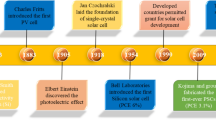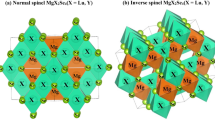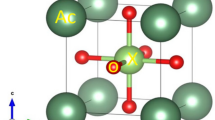Abstract
We investigated the geometrical and electronic properties of copper-doped MoS2 by first principles calculations. The doping is done by Cu substitution with Mo (1 to 4 atoms) accompanied by study of S vacancies. Our outcomes show that the concentration of doping and vacancy of S leads to determine and finely tune the band gap in the range of 0.16 to 1.95 eV. This fine tuning of band gap results due to variation in concentration of impurity, changing dopant site, and production of S vacancies. The resulting arrangements show significant charge redistribution on replacement of local atoms with foreign atoms dictated by electronegativity determined from the Bader analysis. In addition, bonding mechanism occurring due to substitution of foreign elements is discussed. These results give pleasing data regarding fine desired value of the band gap of the MoS2 which helps its utilization in semiconductor and other opto-electronic devices in addition to understanding the electrical conductivity.












Similar content being viewed by others
Data availability
The datasets generated and/or analyzed during the current study are available from the corresponding author on reasonable request.
References
Takada K et al (2003) Superconductivity in two-dimensional CoO2 layers. Nature 422:53–55
Shishidou T, Freeman AJ, Asahi R (2001) Effect of GGA on the half-metallicity of the itinerant ferromagnet (formula presented). Phys Rev B - Condens Matter Mater Phys 64:2–5
Jiang C et al (2018) Robust half-metallic magnetism in two-dimensional Fe/MoS2. J Phys Chem C 122:21617–21622
Reed CA, Cheung SK (1977) On the bonding of FeOsub 2 in hemoglobin and related dioxygen complexes. Proc Natl Acad Sci U S A 74:1780–1784
Puthussery J, Seefeld S, Berry N, Gibbs M, Law M (2011) Colloidal iron pyrite (FeS2) nanocrystal inks for thin-film photovoltaics. J Am Chem Soc 133:716–719
Tang Q, Zhou Z, Chen Z (2015) Innovation and discovery of graphene-like materials via density-functional theory computations. Wiley Interdiscip Rev Comput Mol Sci 5:360–379
Roy K et al (2013) Graphene-MoS 2 hybrid structures for multifunctional photoresponsive memory devices. Nat Nanotechnol 8:826–830
Qiu DY, Da Jornada FH, Louie SG (2013) Optical spectrum of MoS2: many-body effects and diversity of exciton states. Phys Rev Lett 111:1–5
Zhang W et al (2015) Ultrahigh-gain photodetectors based on atomically thin graphene-MoS2 heterostructures. Sci Rep 4:1–8
Tongay S et al (2013) Broad-range modulation of light emission in two-dimensional semiconductors by molecular physisorption gating. Nano Lett 13:2831–2836
Kan M et al (2014) Structures and phase transition of a MoS2 monolayer. J Phys Chem C 118:1515–1522
Ding S, Zhang D, Chen JS, Lou XW (2012) Facile synthesis of hierarchical MoS 2 microspheres composed of few-layered nanosheets and their lithium storage properties. Nanoscale 4:95–98
Wi S et al (2014) Enhancement of photovoltaic response in multilayer MoS2 induced by plasma doping. ACS Nano 8:5270–5281
Wu W et al (2014) Piezoelectricity of single-atomic-layer MoS2 for energy conversion and piezotronics. Nature 514:470–474
Ma D et al (2015) CO catalytic oxidation on iron-embedded monolayer MoS 2. Appl Surf Sci 328:71–77
Shi J, Ma D, Zhang Y, Liu Z (2015) Controllable growth of MoS2 on Au foils and its application in hydrogen evolution. Acta Chim Sin 73:877–885
Kibsgaard J, Chen Z, Reinecke BN, Jaramillo TF (2012) Engineering the surface structure of MoS 2 to preferentially expose active edge sites for electrocatalysis. Nat Mater 11:963–969
Lukowski MA et al (2013) Enhanced hydrogen evolution catalysis from chemically exfoliated metallic MoS2 nanosheets. J Am Chem Soc 135:10274–10277
Hussain A, Tayyab M (2020) Effect of cu concentration and dopant site on the band gap of MoS2: a DFT study. Comput Condens Matter 24:e00494
Maiti UN et al (2014) 25th anniversary article: chemically modified/doped carbon nanotubes & graphene for optimized nanostructures & nanodevices. Adv Mater 26:40–67
Paniagua SA et al (2014) Production of heavily n- and p-doped CVD graphene with solution-processed redox-active metal-organic species. Mater Horizons 1:111–115
Chen W, Qi D, Gao X, Wee ATS (2009) Surface transfer doping of semiconductors. Prog Surf Sci 84:279–321
Tarasov A et al (2015) Controlled doping of large-area trilayer MoS2with molecular reductants and oxidants. Adv Mater 27:1175–1181
Dolui K, Rungger I, Das Pemmaraju C, Sanvito S (2013) Possible doping strategies for MoS2 monolayers: an ab initio study. Phys Rev B - Condens Matter Mater Phys 88:1–9
Wang H et al (2015) Transition-metal doped edge sites in vertically aligned MoS2 catalysts for enhanced hydrogen evolution. Nano Res 8:566–575
Ramasubramaniam A, Naveh D (2013) Mn-doped monolayer MoS2: an atomically thin dilute magnetic semiconductor. Phys Rev B - Condens Matter Mater Phys 87:1–7
Lu SC, Leburton JP (2014) Electronic structures of defects and magnetic impurities in MoS2 monolayers. Nanoscale Res Lett 9
Joseph D et al (2020) Thermoelectric performance of cu-doped MoS2 layered nanosheets for low grade waste heat recovery. Appl Surf Sci 505:144066
Da Cunha WF et al (2019) Tuning the electronic structure properties of MoS2 monolayers with carbon doping. Phys Chem Chem Phys 21:11168–11174
Kresse G, Furthmüller J, Hafner J (1994) Theory of the crystal structures of selenium and tellurium: the effect of generalized-gradient corrections to the local-density approximation. Phys Rev B 50:13181–13185
Blöchl PE (1994) Projector augmented-wave method. Phys Rev B 50:17953–17979
Perdew JP, Burke K, Ernzerhof M (1997) Generalized gradient approximation made simple [Phys. Rev. Lett. 77, 3865 (1996)]. Phys Rev Lett 78:1396–1396
Monkhorst HJ, Pack JD (1976) Special points for Brillouin-zone integrations. Phys Rev B 13:5188–5192
Sun M et al (2017) Electronic and magnetic properties of 4d series transition metal substituted graphene: a first-principles study. Carbon 120
Jing Y, Tan X, Zhou Z, Shen P (2014) Tuning electronic and optical properties of MoS2 monolayer via molecular charge transfer. J Mater Chem A 2:16892–16897
Hussain A, Tayyab M (2020) Effect of cu concentration and dopant site on the band gap of MoS2: a DFT study. Comput Condens Matter 24:e00494
Tang W, Sanville E, Henkelman G (2009) A grid-based Bader analysis algorithm without lattice bias. J Phys Condens Matter 21
Kang J, Liu W, Sarkar D, Jena D, Banerjee K (2014) Computational study of metal contacts to monolayer transition-metal dichalcogenide semiconductors. Phys Rev X 4
Ahmed S et al (2017) Inducing high coercivity in MoS2 nanosheets by transition element doping. Chem Mater 29:9066–9074
Andriotis AN, Menon M (2014) Tunable magnetic properties of transition metal doped MoS2. Phys Rev B - Condens Matter Mater Phys 90
Gui G, Li J, Zhong J (2008) Band structure engineering of graphene by strain: first-principles calculations. Phys Rev B - Condens Matter Mater Phys 78:1–6
Feng LP, Su J, Liu ZT (2015) Effect of vacancies in monolayer MoS2 on electronic properties of Mo-MoS2 contacts. RSC Adv 5:20538–20544
Ma D et al (2016) Modulating electronic, magnetic and chemical properties of MoS 2 monolayer sheets by substitutional doping with transition metals. Appl Surf Sci 364:181–189
Asif QulA, Hussain A, Rafique HM, Tayyab M (2020) Computational study of Be-doped hexagonal boron nitride (h-BN): structural and electronic properties. Comput Condens Matter e00474. https://doi.org/10.1016/J.COCOM.2020.E00474
Tayyab M, Hussain A, Adil W, Nabi S, Asif Q u A (2020) Band-gap engineering of graphene by Al doping and adsorption of Be and Br on impurity: a computational study. Comput Condens Matter 23:e00463
Qin S, Lei W, Liu D, Chen Y (2014) In-situ and tunable nitrogen-doping of MoS2 nanosheets. Sci Rep 4:1–5
Andriotis AN, Menon M (2014) Tunable magnetic properties of transition metal doped MoS2. Phys Rev B - Condens Matter Mater Phys 90:1–7
Tayyab M, Hussain A, Asif Q u A, Adil W (2020) Band-gap tuning of graphene by Mg doping and adsorption of Br and Be on impurity: A DFT study. Comput Condens Matter 23:e00469
Asif Q u A, Hussain A, Rafique HM, Tayyab M (2020) Computational study of Be-doped hexagonal boron nitride (h-BN): Structural and electronic properties. Comput Condens Matter 23:e00474
Zhao P et al (2017) Electronic and magnetic properties of re-doped single-layer MoS2: a DFT study. Comput Mater Sci 128:287–293
Tsai C et al (2017) Electrochemical generation of sulfur vacancies in the basal plane of MoS2 for hydrogen evolution. Nat Commun 8:1–8
Acknowledgements
The authors would like to thank University of Malakand KPK and Pakistan Institute of Nuclear Science & Technology Islamabad Pakistan for computational facilities. Finally, I would like to thank my wife for providing useful discussion on writing the manuscript.
Code availability
N/A
Author information
Authors and Affiliations
Contributions
Muhammad Tayyab and Akhtar Hussain performed the material search, computational simulations, and analysis of the data and wrote the manuscript. Waqar Adil Syed, Shafqat Nabi, and Qurat ul Ain Asif remained involve in valuable discussion on the research work.
Corresponding author
Ethics declarations
Ethics approval
This study does not require any ethical clearance.
Consent to participate
Informed consent was obtained from all individual participants included in the study.
Consent for publication
The participants have consented to the submission of the case report to the journal.
Conflict of interest
The authors declare no competing interests.
Additional information
Publisher’s note
Springer Nature remains neutral with regard to jurisdictional claims in published maps and institutional affiliations.
Rights and permissions
About this article
Cite this article
Tayyab, M., Hussain, A., Syed, W.A. et al. Effect of copper concentration and sulfur vacancies on electronic properties of MoS2 monolayer: a computational study. J Mol Model 27, 213 (2021). https://doi.org/10.1007/s00894-021-04834-w
Received:
Accepted:
Published:
DOI: https://doi.org/10.1007/s00894-021-04834-w




